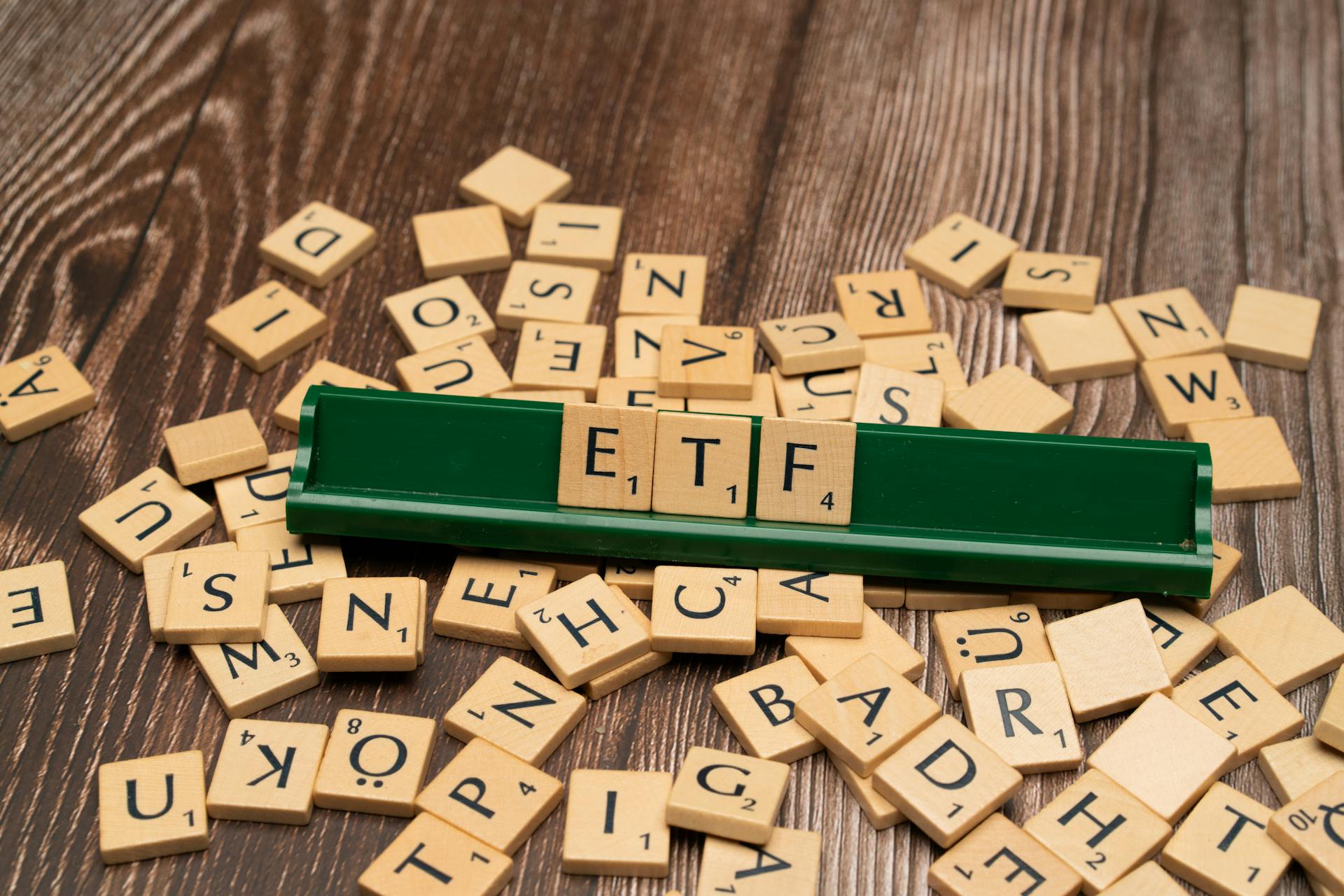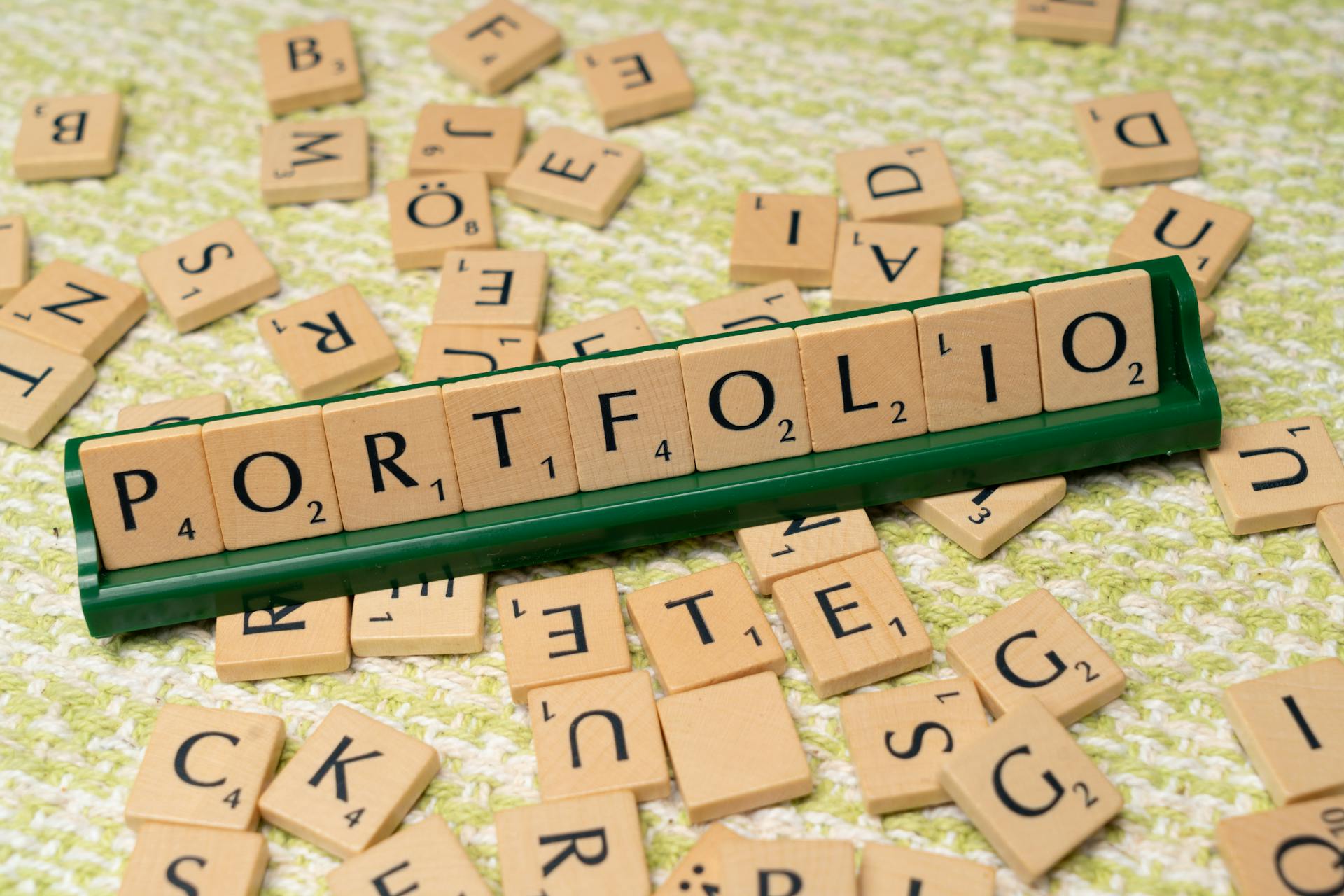
Buying ETFs can seem daunting, but it's actually quite straightforward. You can buy ETFs through a brokerage account, which you can open online with a reputable firm like Fidelity or Vanguard.
To start, you'll need to fund your account with money to invest. You can do this by transferring funds from your bank account, or by wiring money directly to the brokerage firm. The minimum amount required to open an account varies by firm, but it's often around $100.
Once your account is funded, you can browse the available ETFs and select the ones you want to buy. Be sure to review the fees associated with each ETF, as they can eat into your returns.
Readers also liked: Best Etfs for Brokerage Account
Getting Started
To get started with buying ETFs, you need to open a brokerage account. This is the first step in investing in ETFs.
Having a brokerage account allows you to buy and sell securities, including ETFs, in a secure and regulated environment.
To open a brokerage account, you'll typically need to provide some personal and financial information, such as your name, address, and social security number.
Choose your first ETFs wisely, as this will set the tone for your investment portfolio.
Consider your investment goals, risk tolerance, and time horizon before selecting your ETFs.
Let your ETFs do the hard work for you, as they can provide diversification and potentially lower fees compared to individual stocks.
A unique perspective: Are Etfs Good
Understanding ETFs
ETFs come in two basic types: passive and active. Passive ETFs simply track a stock index, such as the S&P 500, while active ETFs hire portfolio managers to invest their money.
Passive ETFs aim to match an index's performance, whereas active ETFs aim to beat it. This fundamental difference is crucial to understand when choosing between the two.
ETFs charge fees, known as expense ratios, which are listed as an annual percentage. For example, a 1% expense ratio means you'll pay $10 in fees for every $1,000 invested. Lower expense ratios can save you money in the long run.
A different take: Passive Etfs
Expense Ratio & Fees
ETFs are typically offered at lower expense ratios, on average. This can save you money in the long run.
Traditional mutual funds have slightly higher expenses, potentially including 12b-1 fees and load in/out fees, in addition to management fees. These extra costs can add up quickly.
ETFs often have lower fees because they don't have the same operational costs as traditional mutual funds. This is one reason why ETFs are becoming increasingly popular.
In addition to lower expense ratios, ETFs also have fewer fees overall. This can make them a more cost-effective option for investors.
Broaden your view: Why Etfs Are Better than Mutual Funds
ETF vs. Index Fund: Key Differences
Your investment style can dictate which kind of fund is best for your portfolio.
If you're a hands-on investor, an ETF might be the way to go, as it allows you to buy and sell individual securities throughout the day.
An index fund, on the other hand, tracks a specific market index, like the S&P 500, and doesn't require you to actively manage your portfolio.
Readers also liked: Spdr Portfolio Etfs
The main difference between an ETF and an index fund is that an ETF is traded on an exchange like a stock, while an index fund is a mutual fund that's priced at the end of the day.
Ultimately, the choice between an ETF and an index fund depends on your investment goals and style.
If this caught your attention, see: Hedge Fund Etfs
Investment Strategy
To develop an effective investment strategy, consider your investing style. If you're a hands-off investor, passively managed ETFs that track an index may be the way to go.
ETFs can have varying costs, so it's essential to be aware of these expenses. Even ETFs tracking the same index can have different costs, depending on the issuer and complexity.
When choosing your first ETFs, consider the fees and whether they align with your investment thesis. Don't be swayed by low costs alone, as some funds may not provide much diversification.
Here are some key factors to keep in mind when selecting your ETFs:
- Passively managed ETFs are generally cheaper.
- Actively managed ETFs come with higher fees.
- Consider your investing style before buying.
Remember, your investment strategy should be tailored to your individual needs and goals. Take the time to research and choose ETFs that fit your broader investment thesis.
Consider reading: Are Semiconductor Etfs a Good Investment
Low-Cost Investment Strategy
A low-cost investment strategy is a great way to start building wealth without breaking the bank. Costs for ETFs can vary widely, depending on the issuer, complexity, and demand, so it's essential to shop around.
Even ETFs tracking the same index have different costs. This means you should compare fees before making a decision.
Passively managed investments like ETFs are often the way to go, as they simply track an index and are generally lower-cost. However, some investors prefer the hands-on approach of mutual funds, which are run by a professional manager.
If you're new to investing, consider starting with a brokerage account and choosing a few low-cost ETFs to get started. Let your ETFs do the hard work for you.
Here are some things to consider when choosing a low-cost investment strategy:
It's also important to be aware of gimmicky funds that may not provide much diversification, even if they're cheap. Just because an ETF is low-cost doesn't mean it's right for you.
Flexibility
ETFs are bought and sold at the market price, which fluctuates based on trading activity.
You can buy ETFs on an intraday basis, providing access to the market and your investments throughout the trading day.
ETFs trade on an exchange during market hours, similar to a stock.
This means you can use limit orders or stop-loss orders to manage your investments.
Traditional mutual funds, on the other hand, do not trade all day; they are only available for purchase or redemption once per day.
All of that day's orders are executed at the same price, which may not be ideal for investors who want more flexibility.
Additional reading: Trading Etfs
Choosing the Right ETF
The cost of ETFs can vary widely from fund to fund, depending on the issuer and complexity. This means that even ETFs tracking the same index have different costs.
You'll want to consider your investing style before buying. If you prefer a hands-on approach, you might prefer mutual funds, but if you're looking for a low-maintenance option, ETFs are the way to go.
Some ETFs are borderline gimmicky, taking a thin slice of the investing world and not providing much diversification. Make sure the ETF you choose fits with your broader investment thesis, even if it's cheap.
Here are some key factors to consider when choosing an ETF:
Step 2: Choose First
Choosing your first ETFs can be a daunting task, but don't worry, I've got you covered. Most beginners prefer passive index funds, which are generally cheaper and have a proven track record.
These funds are cheaper because they don't have a professional manager trying to beat the market, which can be a costly endeavor. In fact, most actively managed funds don't even beat their benchmark index over time.
For beginners, it's essential to start with a solid foundation, and index funds provide that. They offer broad diversification and can be a great way to get started with ETF investing.
Here are some popular ETFs for beginners to consider:
Remember, the key is to start with a solid foundation and let your ETFs do the hard work for you. By choosing a reputable and low-cost ETF, you'll be well on your way to building a successful investment portfolio.
What Do
When evaluating ETFs, it's essential to consider their investment objective.
A broad-based ETF can provide exposure to a wide range of assets, such as stocks, bonds, or commodities.
The investment objective of an ETF can be actively managed or passively managed.
Some ETFs are designed to track a specific market index, like the S&P 500.
The expense ratio of an ETF can significantly impact its overall performance.
A lower expense ratio can result in higher returns over time.
The trading volume of an ETF can affect its liquidity and price.
A highly liquid ETF can be easier to buy and sell.
The tax implications of an ETF can also be a consideration.
Index ETFs are often more tax-efficient than actively managed ETFs.
Worth a look: Etfs Ireland Tax
Value
When choosing an ETF, consider the value it offers. Actively managed ETFs can provide more personalized investment strategies, but they often come with higher fees.
Competitive pricing is a key aspect of value. Index ETFs, on the other hand, typically have lower fees and are often more affordable.
Trading flexibility is also an important consideration. With competitive pricing and trading flexibility, you can make informed investment decisions that align with your financial goals.
If this caught your attention, see: Value vs Growth Etfs
Minimum Investments
One of the biggest advantages of ETFs is the low minimum investment required to get started. You can buy a single share or even a fraction of a share for less than $100, often much lower.
ETFs are purchased in shares at market price, just like individual stocks, making it easy to start investing with a small amount of money. This flexibility is a major draw for many investors.
Traditional mutual funds, on the other hand, often have higher minimum initial investments, sometimes reaching into the thousands of dollars. This can be a barrier for those who want to start investing but don't have a lot of money to spare.
Subsequent mutual fund investments may not have a minimum to meet, but the initial investment can be a hurdle for many people.
Check this out: Investing in Etfs for Dummies
Fidelity Large Cap Core ETF
The Fidelity Large Cap Core ETF is a U.S. equity strategy that maintains a large-cap core profile.
It leverages a disciplined approach to investing in companies with attractive characteristics. This approach helps to identify and invest in top-performing companies with stable growth potential.
By focusing on large-cap companies, the ETF aims to provide a stable and consistent return over time.
Explore further: Ishares Core Msci Eafe Etf
Frequently Asked Questions
What ETF site is best?
For a comprehensive and reliable source of ETF information, consider visiting multiple sites such as VanEck, Invesco, and justETF, which offer detailed data and insights. Each site has its unique strengths, so exploring them can help you find the best fit for your needs.
How much should a beginner invest in ETFs?
There is no minimum investment amount for ETFs, making it accessible to beginners with any budget. Start with a small investment and explore the world of ETFs to find the right fit for your financial goals.
Featured Images: pexels.com


